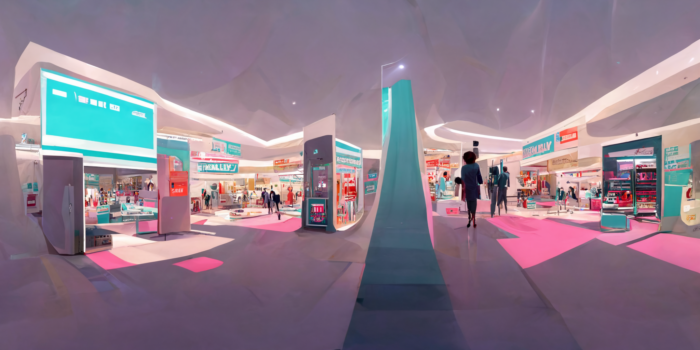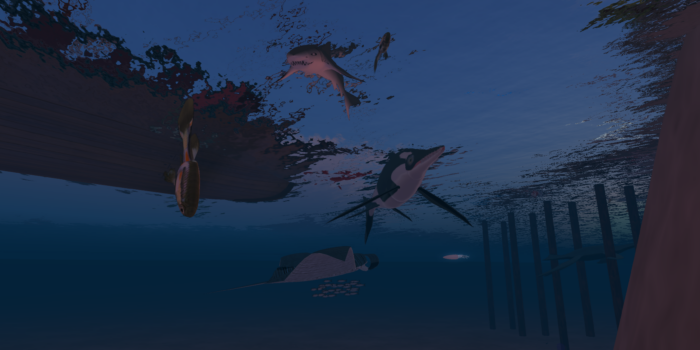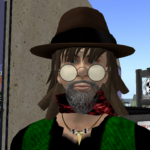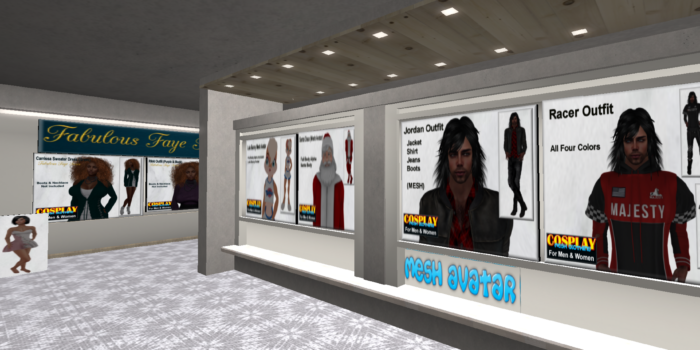
There are a variety of businesses that exist only — or at least mainly — inside OpenSim worlds. Those businesses are often run by creative artists who use their talents to make digital art which they market as products to customers in OpenSim.
Avatar skins, shapes, clothing, hair, jewelry, and other accessories are all products sold by in-world merchants. Vehicles, homes, furniture, gadgets, weapons, ships, landscaping, and plants can also be bought.
Even components to make different items are sold for others to put together and sell. For instance, doors and windows for buildings, or fences and signs to be put together with larger builds. There are sculpts and shade maps that can be textured and resold. And of course, textures provide colors and realistic surfaces for items.
There are scripts to make things go. They make doors open and close, vehicles move, avatars sit, and instruments – which are also sold – play. The scripts also make sounds, songs, and other music. For an item to be animated in some way, it must have a script.
Some of the merchants in OpenSim create items and the scripts that animate them. HyperGrid Business was able to catch up with one of those creators in-world.

Kayaker Magic
Kayaker Magic models his creations and then scripts them to make them more realistic. He operates in more than one location.
Ocean Engineering is Kayaker Magic’s store that specializes in making scripted products for virtual worlds.
Ocean Engineering sells imaginary, and realistic creatures along with various recreational items like surfboards, boats, weapons, and plants, as well as, items and scripts for other people’s builds.
Kayaker started his business when he was in Second Life but now concentrates on OpenSim.
“I still have some things I left behind in the Second Life marketplace and a few dollars trickle in every month,” said Kayaker. “But I’d like to say all my best work has been done since I left Second Life.”

One of the reasons Kayaker moved his products from Second Life to OpenSim was the high cost of doing business there.
“For one thing, land prices are ridiculously high,” Kayaker said, adding that it cost $1,000 to add a new server to a server farm in Second Life’s early days.
“To have your own private land in Second Life, you had to pay a $1,000 setup fee, and then you had to pay $250 a month,” he said.
Kayaker pointed out that even though the cost of service and connectivity has gone down over the decades, Second Life never lowered its prices significantly.
“I’m mostly concentrated in the Kitely Market, and I have demo versions of most products in two regions in Kitely,” said Kayaker. “I have a few vending machines in Discovery Grid where I hang out a lot for all the connected ocean regions,” he said.
Kayaker already has plans for his next move.
“I would like to upgrade all the critters that I sell and make them out of Animesh,” he said. “I have a million other product ideas with no time to get to them all!”

Artman Xue
Another business person who moved from Second Life to OpenSim is Artman Xue.
“I’ve been in business 12 years and got started in Second Life,” Artman explained. “My first business was Artman Designs and I made system clothes.”

Artman now has two stores — Cosplay Corner, located in Digiworldz, and Cosplay Mesh, found on Discovery Grid.
Some of the items he sells include avatars, cosplay characters, and men’s and women’s clothing.
“My future plans are for making children’s clothing,” said Artman about his plans for OpenSim.
If you know of a virtual business person, artist, performer, or someone else who has something to say about business in virtual reality, ask them to get in touch with me at marystoll@mcstoll.com
- Neuralink pushes back public demonstration of its brain-computer interface - October 28, 2022
- Virtual merchants in OpenSim - October 18, 2022
- Zuckerberg announces Meta Quest Pro and more - October 12, 2022
